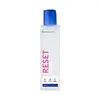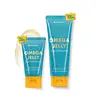What's inside
What's inside
 Key Ingredients
Key Ingredients

 Benefits
Benefits

 Concerns
Concerns

No concerns
 Ingredients Side-by-side
Ingredients Side-by-side

Water
Skin ConditioningPEG-6 Caprylic/Capric Glycerides
EmulsifyingPropanediol
SolventDipropylene Glycol
HumectantPentylene Glycol
Skin ConditioningCalendula Officinalis Flower Extract
MaskingArtemisia Vulgaris Extract
Skin ConditioningAloe Barbadensis Leaf Extract
EmollientPanthenol
Skin ConditioningCaprylyl Glycol
EmollientEthylhexylglycerin
Skin ConditioningMagnesium Aspartate
Skin ConditioningZinc Gluconate
Skin ConditioningSodium Citrate
BufferingCitric Acid
BufferingSodium Phytate
1,2-Hexanediol
Skin ConditioningPhenoxyethanol
PreservativeCopper Gluconate
Skin ConditioningButylene Glycol
HumectantOctanediol
Tocopherol
AntioxidantWater, PEG-6 Caprylic/Capric Glycerides, Propanediol, Dipropylene Glycol, Pentylene Glycol, Calendula Officinalis Flower Extract, Artemisia Vulgaris Extract, Aloe Barbadensis Leaf Extract, Panthenol, Caprylyl Glycol, Ethylhexylglycerin, Magnesium Aspartate, Zinc Gluconate, Sodium Citrate, Citric Acid, Sodium Phytate, 1,2-Hexanediol, Phenoxyethanol, Copper Gluconate, Butylene Glycol, Octanediol, Tocopherol
C13-14 Isoparaffin
EmollientCaprylic/Capric Triglyceride
MaskingIsopropyl Palmitate
EmollientWater
Skin ConditioningLauryl Glucoside
CleansingGlycerin
HumectantOleth-10
EmulsifyingCetearyl Glucoside
EmulsifyingButylene Glycol
HumectantPyrus Malus Seed Oil
EmollientHippophae Rhamnoides Fruit Oil
Skin ProtectingDaucus Carota Sativa Seed Oil
EmollientDianthus Chinensis Extract
HumectantPaeonia Suffruticosa Extract
Skin ConditioningTocopheryl Acetate
AntioxidantCalendula Officinalis Flower Oil
MaskingArtemisia Capillaris Extract
Centella Asiatica Extract
CleansingCitric Acid
Buffering1,2-Hexanediol
Skin ConditioningHydroxyacetophenone
AntioxidantC13-14 Isoparaffin, Caprylic/Capric Triglyceride, Isopropyl Palmitate, Water, Lauryl Glucoside, Glycerin, Oleth-10, Cetearyl Glucoside, Butylene Glycol, Pyrus Malus Seed Oil, Hippophae Rhamnoides Fruit Oil, Daucus Carota Sativa Seed Oil, Dianthus Chinensis Extract, Paeonia Suffruticosa Extract, Tocopheryl Acetate, Calendula Officinalis Flower Oil, Artemisia Capillaris Extract, Centella Asiatica Extract, Citric Acid, 1,2-Hexanediol, Hydroxyacetophenone
Ingredients Explained
These ingredients are found in both products.
Ingredients higher up in an ingredient list are typically present in a larger amount.
1,2-Hexanediol is a synthetic liquid and another multi-functional powerhouse.
It is a:
- Humectant, drawing moisture into the skin
- Emollient, helping to soften skin
- Solvent, dispersing and stabilizing formulas
- Preservative booster, enhancing the antimicrobial activity of other preservatives
Butylene Glycol (or BG) is used within cosmetic products for a few different reasons:
Overall, Butylene Glycol is a safe and well-rounded ingredient that works well with other ingredients.
Though this ingredient works well with most skin types, some people with sensitive skin may experience a reaction such as allergic rashes, closed comedones, or itchiness.
Learn more about Butylene GlycolCitric Acid is an alpha hydroxy acid (AHA) naturally found in citrus fruits like oranges, lemons, and limes.
Like other AHAs, citric acid can exfoliate skin by breaking down the bonds that hold dead skin cells together. This helps reveal smoother and brighter skin underneath.
However, this exfoliating effect only happens at high concentrations (20%) which can be hard to find in cosmetic products.
Due to this, citric acid is usually included in small amounts as a pH adjuster. This helps keep products slightly more acidic and compatible with skin's natural pH.
In skincare formulas, citric acid can:
While it can provide some skin benefits, research shows lactic acid and glycolic acid are generally more effective and less irritating exfoliants.
Most citric acid used in skincare today is made by fermenting sugars (usually from molasses). This synthetic version is identical to the natural citrus form but easier to stabilize and use in formulations.
Read more about some other popular AHA's here:
Learn more about Citric AcidWater. It's the most common cosmetic ingredient of all. You'll usually see it at the top of ingredient lists, meaning that it makes up the largest part of the product.
So why is it so popular? Water most often acts as a solvent - this means that it helps dissolve other ingredients into the formulation.
You'll also recognize water as that liquid we all need to stay alive. If you see this, drink a glass of water. Stay hydrated!
Learn more about Water